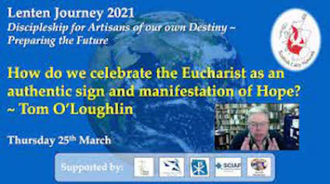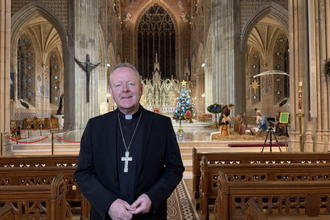Scottish Laity Network Lenten Series 6: 'How do we celebrate the Eucharist as an authentic sign and manifestation of Hope?'

In the final session of the Scottish Laity Network's Lenten Journey 2021 Tom O'Loughlin - Professor of Historical Theology at the University of Nottingham - shared on the theme, 'How do we celebrate the Eucharist as an authentic sign and manifestation of Hope?'
Reflecting on the impact of COVID19 and the lockdowns Tom spoke of how the passionate way people were expressing the need to meet and gather as community was something that was rooted in human DNA. We humans just love talking to one another. We are the social animals par excellence and this is what Christians have been saying about the human condition for 2000 years and what Judaism said for another 1000 years. This is important because it suggests that human beings form not any sort of community, but a community in which they flourish. Full human potential requires that we can not only see each other and talk to each other, but can actually embrace each other.
For Christians the pandemic challenges us to affirm and make manifest that we are the religion of community. We are not saved as an individual. The whole community is saved and we have chosen to belong to that community. Baptism is not our pass ticket into heaven. Baptism is our entry and acceptance of discipleship within the Church. Within that community, where we seek to love one another, as the Lord has loved us, and to grow to the fullness of our humanity.
Exploring the development of human community Tom emphasised the importance of gathering around the table. He said the table is our natural environment and it therefore should come as no surprise that within Judaism, the place to pray is during the sharing of food, and the place to express thanks to God and to mark the great acts of God through the year, is not in a building. The synagogue is a teaching institution, the temple is unique, but day to day life took place around the table.
It was there that God was thanked for the gift and blessing of creation which made the meal possible. At the beginning of the meal there was thanks for providing the food and then at the end of the meal there was thanks for the joy and sharing of the meal. That's why we read that Jesus blessed at the beginning of the supper and then when supper was ended, he blessed again. We are therefore called to be a community that gather and express ourselves in the most human of ways, around a common table establishing a new family of God as brothers and sisters. We are called to carry out our Eucharist in the Jesus way, as a meal of thanksgiving.
However Tom acknowledged that sadly that is not anything like the experience of the average Catholic Sunday. For there tends to be no sense of being a guest at a community meal and because of this we have a major problem because this is not a human experience that has any human meaning.
Linking in with the overall theme of our Lenten Journey, Tom said that the challenge in building a future, is to build community celebrations that are humanly meaningful. Once we build a celebration that's humanly meaningful, it can then be sacramental and point beyond the human, to the divine. But at the moment we have sacraments which we say are a sign, because they are physical realities pointing beyond themselves to spiritual realities. But the reality of today is that they're not human realities. They're merely tokens.
Tom said that if asked 'How does the Eucharist of the future differ from what we've done? he would put it in two words, 'get real'. If we are really having a community meal, then we can start by exploring how that community meal echoes the meals of Jesus. Christianity begins in a meal; it ends in a meal and our Sunday experience should be a meal.
That central thrust has been inverted. Reality in terms of our everyday experience is just an add on. It's the technical bit that's real. But that's not how people work. If faith doesn't make sense in the ordinariness of things, how can it be a pointer to the extra-ordinariness of things.
For Tom, if we are going to thank the Father in the Jesus fashion we should actually be eating a real loaf and ideally one that someone in the community actually prepares. Similarly for the drinking we should be joyfully drinking as we would at any community celebration. Service is another key ingredient and just as we're supposed to serve one another in our daily life, we serve one another at this meal. From this experience we could then move on to start talking about a real community and the real liturgy that opens up to the divine.
Sadly at the moment we are all too likely to think there's reality and there's liturgy. There's every day and there's Mass. We have to clearly state that it is the midst of everyday life we are a community and we express that by coming together and when we come together everyone should feel that they have a place at the table. We have to think of the table not as the place of reward, but the place of welcome. The table becomes the symbol of the reconciliation that the church preaches. A reconciliation that boldly states there's always space for one more. Then we can actually think of ourselves as really at a banquet. This banquet will cast our minds back so that we are praising the Father in the Jesus way and it will also cast our minds forward to the banquet beyond this life.
Referring to the work of Robin Dunbar on the optimal size for a human community Tom reflected on that in the context of our Eucharist. As human beings we can't operate beyond 150 and we operate best between 20 and 75. Too small and it's encroaching on our families. Too big and it just becomes an organization and we feel a number in it. We have to think of our communities as real human communities, which just can't be scaled up.
Regarding the optimal size of community Tom shared that Columba on Iona some 1400 years ago discerned that the largest monastery that could exist was 150 monks. And he said "If it's more than that, 12 should leave with an Abbot." 13 of them should go off and found a monastery somewhere. Tom added that St Paul speaking to synagogues probably never spoke to a community that was larger than 20 men and that from the size of buildings in Corinth that early Eucharistic communities were about maximum, if you squeezed everyone in, 30 or 40 people.
Concluding with thinking in terms of real groups who have real dynamism within them Tom asked 'Where do we get our clergy from?'
His answer focussed around the current clergy laity divide and he suggested that within the vision he had shared it would no longer exist, for this new Eucharistic community will be a place where all are engaged. We are wholly celebrant. We would then find within our communities, those who are called to lead us in our service, those who are called to lead us in our remembering and those who are called to lead us in our gathering around the table.
Drawing on the theology of Calvinist communities, Tom pointed out that the preacher would be seen as being directly appointed by the Holy Spirit, a direct charismatic appointment. That's why there are so many tiny little medieval church names all over Scotland, because these were small communities. They had one of their own who was then ordained to be their priest. So we have to think of this as a real community, sharing in a real meal, with a real leader who belongs within the community. Then if it is humanly real, it can be sacramental of that, which is greater than our reality.
You can watch the recording at: https://youtu.be/3Ys7cZRdg9I


















